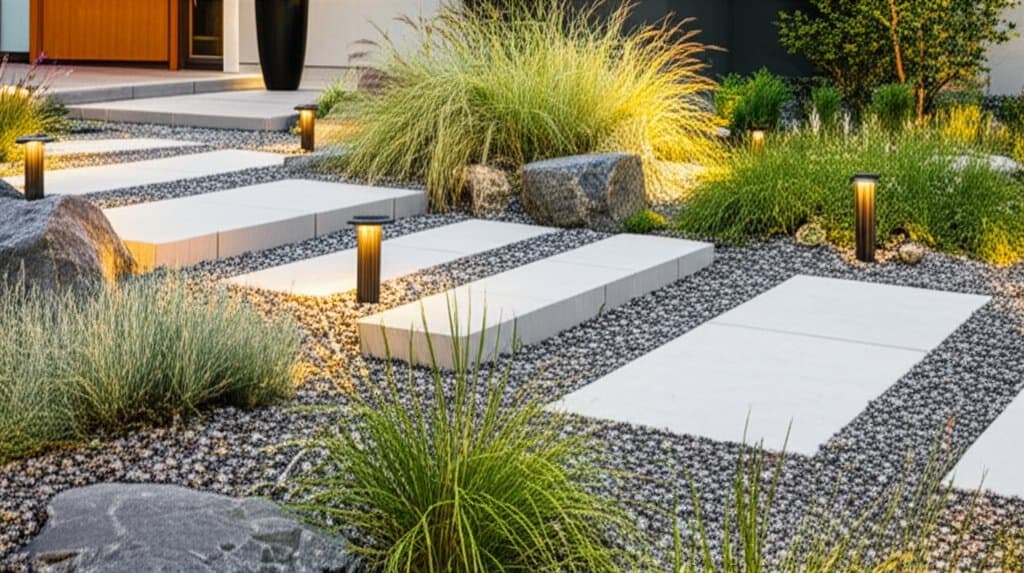Key Points
- Gravel gardens provide a low-maintenance option that tolerates drought far better than conventional lawns.
- Thorough preparation of the base ensures optimal drainage and effective weed suppression.
- Homeowners manage the primary installation tasks, though professionals assist with grading or extensive excavation.
- Initial expenses depend on gravel varieties and plant choices, yet ongoing savings in water and labor justify the investment.
- Construction executed with care yields landscapes that endure for years under light upkeep.
Project Overview
Working Time: 2 to 3 days
Total Time: Approximately one week, accounting for soil preparation and plant rooting
Skill Level: Intermediate
Estimated Cost: Moderate to high initial outlay, with minimal recurring expenses
A gravel garden stands as a practical solution for supplanting labor-intensive lawns. This approach merges structured aesthetic elements with reduced irrigation needs and the elimination of mowing routines. Residents in arid climates or those seeking to lower utility costs find this method delivers both utility and visual charm.
When to DIY vs Hire
Materials and Tools
Materials:
- Landscape fabric or robust weed barrier
- Crushed stone base, sized at three-quarters inch
- Surface decorative gravel or pea stone
- Edging options such as metal strips, natural stone, or pressure-treated lumber
- Drought-resistant flora including lavender, sedum, and ornamental grasses
Tools:
- Shovel and rake
- Wheelbarrow
- Tamper or plate compactor
- Utility knife for fabric cutting
- Garden hose for establishment watering
Budget adaptations include opting for recycled concrete as a base material. Local quarries frequently provide bulk purchases at reduced rates for various stone types.
Step-by-Step Process
1. Clear and Grade the Area
Eliminate existing turf, weeds, and refuse from the site. Employ a flat-edged shovel or sod cutter to lift grass efficiently. Level the ground with a rake, ensuring a gentle slope directs water away from structures. Import crushed stone in modest quantities to elevate any depressions as required.
2. Install the Weed Barrier
Unroll landscape fabric over the prepared surface, with overlaps of at least six inches at joints. Anchor the fabric using landscape staples or weighted stones. This layer proves vital for weed deterrence and sustained tidiness. Select permeable fabrics over plastic to permit soil aeration and moisture regulation.
3. Add the Gravel Base
Distribute a layer of crushed stone two to three inches thick across the area. Compact the material thoroughly with a tamper. This foundation facilitates water percolation and stabilizes the overlying gravel against subsidence. A firm base also supports foot traffic without uneven settling.
4. Spread the Decorative Gravel
Apply the surface gravel layer to a depth of about two inches. Select sizes and hues that align with your aesthetic preferences; rounded pea gravel suits softer textures, whereas angular varieties interlock securely for paths. Even the distribution with a rake and secure boundaries using edging to contain the material.
5. Plant and Water
Create precise incisions in the fabric at planting locations. Excavate holes accommodating the root systems, then refill with amended soil prior to positioning plants. Deliver a deep initial watering to promote root development. Maintain irrigation every few days during the initial weeks, gradually reducing frequency as vegetation adapts.
Quality Control and Finishing Touches
Verify that the completed garden sheds water rapidly following precipitation and suppresses weed emergence. Address any pooling by incorporating additional base stone beneath affected zones. Preserve uniform gravel depth through periodic raking to realign shifted particles. Edging installation around adjacent hardscapes prevents migration into driveways or paths.
Incorporate diverse plant forms and elevations for enhanced visual interest. Pair trailing groundcovers such as thyme with upright specimens like yucca or grasses. Such combinations foster a deliberate, multifaceted composition that avoids barren appearances.
Long-Term Maintenance
Gravel gardens demand far less attention than turf surfaces. Allocate a few hours per season to remove litter, extract stray weeds, and replenish thinned gravel areas. Regular raking restores the surface's pristine condition with minimal effort.
Pro Tips for Success
- Select flora native to the region or suited to Mediterranean conditions that flourish in arid soils.
- Steer clear of overly fine gravels prone to excessive compaction, which impedes water flow.
- Employ varied gravel tones or dimensions to delineate routes or highlight features.
- Examine drainage performance after intense rainfall events.
- Renew the surface layer periodically, every few years, to sustain vibrancy.
Extending Your Landscaping Expertise
Mastery of gravel garden techniques transfers seamlessly to related endeavors. Principles of base layering and drainage underpin dry stream simulations, gravel terraces, and ornamental trails. This lawn substitution conserves resources and effort, yielding a refined outdoor environment that embodies thoughtful design and enduring value.




